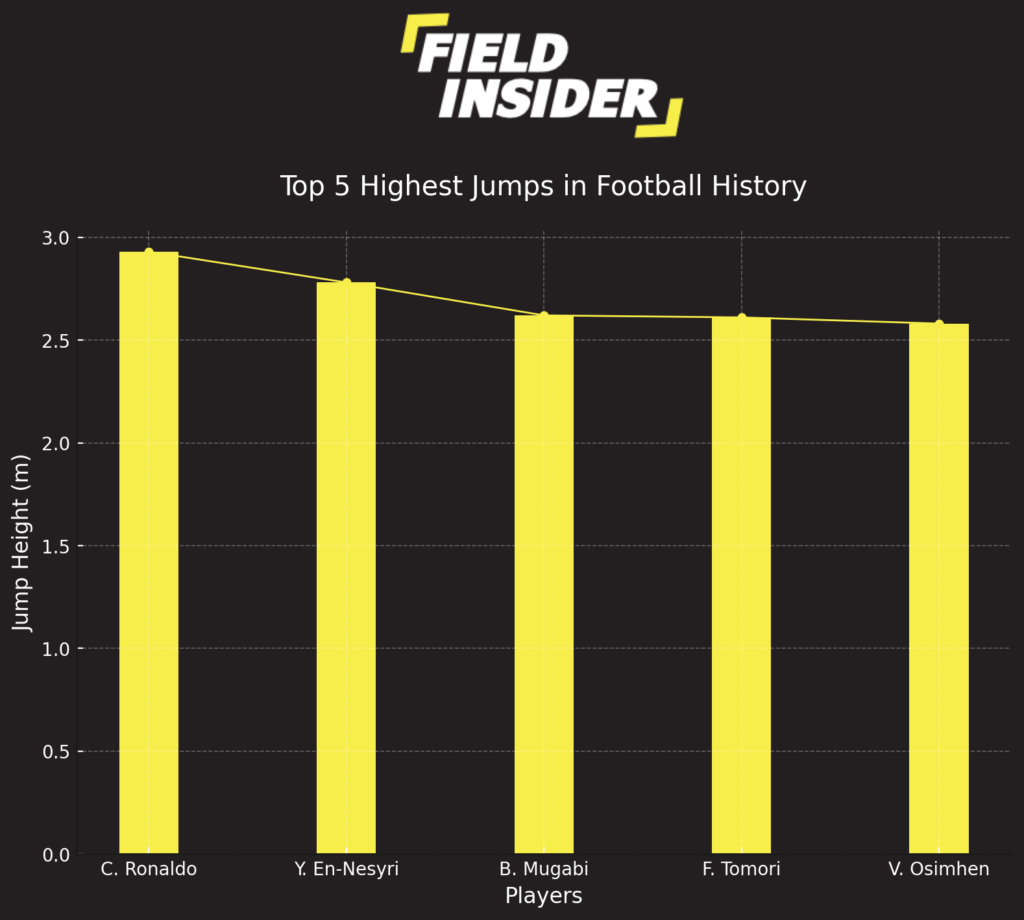How Do Footballers Jump High? Full Guide
High jumping in football captivates audiences and players alike, merging aerial finesse with a tactical advantage during crucial game situations.
Cultivating the skill of high jumping in football is vital, enhancing a footballer’s performance significantly and influencing game outcomes, while adding an exhilarating element to the sport.
Key Takeaways
| Aspect | Details |
|---|---|
| Physics | Exploring leg power, angular momentum, takeoff angle, and speed. |
| Techniques | Covering plyometric exercises, strength training, flexibility, and running form. |
| Case Studies | Analyzing the high jumping skills of Cristiano Ronaldo, Zlatan Ibrahimović and Sergio Ramos. |
| Common Mistakes | Identifying and correcting common high jumping errors. |
| Coaching | The significance of coaching and video analysis in skill development. |
| Real-Life Application | How high jumping benefits footballers in various match situations. |
The Physics Behind High Jumps

The Role of Leg Power
Leg power is the cornerstone of high jumping in football. This involves more than just raw power; it’s about the effective translation of energy from the legs to achieve maximum lift.
Understanding the mechanics of leg extension is crucial, as it dictates the force exerted during the jump. For a deeper exploration of training for leg strength, visit our comprehensive guide on how footballers train their legs.
Utilizing Angular Momentum
The concept of angular momentum is pivotal in mastering the high jump. It’s about controlling the body’s rotation and balance in mid-air, which is key to achieving not just height but also precision in landing.
Angular momentum helps players manage their center of gravity, crucial for successful and injury-free jumps. Insights into effectively using body mechanics can be further explored in our article on football agility.
Takeoff Angle and Speed
Understanding the optimal takeoff angle is essential for maximizing jump height. This angle, coupled with the correct approach speed, determines the overall effectiveness of the jump.
High speed on the approach translates to more lift, but it must be balanced with the right angle to avoid loss of control or precision.
Techniques for Improving High Jumps
Plyometric Exercises
Plyometric exercises, such as box jumps and depth jumps, are fundamental for enhancing high jump performance in football.
Box jumps focus on explosiveness and leg strength, crucial for the initial thrust. Depth jumps, on the other hand, improve reactive strength and agility, essential for quick, powerful leaps.
Strength Training
Strength training, encompassing exercises like squats, deadlifts, and calf raises, is crucial for building the muscular foundation needed for high jumps. Squats and deadlifts enhance core and overall leg strength, while calf raises target the specific muscles used during jump takeoff.
This comprehensive approach to strength training is key to achieving explosive jumping power, as further explained in our article on physical training in football.
Flexibility and Mobility
Flexibility and mobility exercises are often underrated but are vital for high jumpers in football. They ensure a full range of motion, crucial for achieving the highest jumps, and help prevent injuries.
Incorporating these exercises into regular training routines enhances overall athletic performance.
Proper Running Form
Proper running form, including optimized stride length and frequency, plays a significant role in building momentum for high jumps.
Maintaining balance during the run-up is equally important, as it affects the efficiency of the takeoff. This aspect of high jumping ties into overall athletic training.
Case Studies of Footballers with Impressive High Jumps

Cristiano Ronaldo
Cristiano Ronaldo, renowned for his extraordinary leaping ability, showcases the perfect blend of physical prowess and technique. His training regimen, focusing heavily on leg strength and plyometric drills, is a testament to his dedication to mastering high jumps.
Zlatan Ibrahimovic
Zlatan Ibrahimovic, with his towering presence and athletic build, exemplifies the power of high jumping in football. His training emphasizes not just strength but also agility, enabling him to make remarkable leaps in the air.
Zlatan’s ability to use his height, combined with his jumping skills, makes him a formidable threat during aerial duels.
Sergio Ramos
Sergio Ramos is another exceptional example of aerial prowess in football. Known for his defensive skills, Ramos also excels in using high jumps effectively, especially during set pieces.
His approach combines strength training with tactical knowledge, allowing him to position himself optimally for jumps.
Top 5 Highest Jumps in Football History

The above bar chart, titled “Top 5 Highest Jumps in Football History,” visualizes the highest jumps made by football players, focusing on the top five as recorded;
- Cristiano Ronaldo’s Record Jump: At the top of the list is Cristiano Ronaldo with a jump of 2.93 meters against Manchester United, which is the highest recorded jump in football history.
- Global Representation: The list includes players from various nationalities and leagues, illustrating the global nature of this athletic achievement.
- Significant Heights: All the jumps listed are above 2.4 meters, which is a considerable height, especially when considering the athletes are also managing to control a football during play.
- Top Five Jumps: The five highest jumps range from 2.58 to 2.93 meters, with Cristiano Ronaldo’s jump nearly reaching the 3-meter mark.
- Ronaldo’s Dominance: Cristiano Ronaldo is mentioned five times in the top 10, indicating his exceptional aerial ability and consistency in making high jumps. This fact underscores Ronaldo’s physical prowess and his extraordinary skill in aerial football situations.
- Comparison of Athletes: Youssef En-Nesyri ranks second with a 2.78-meter jump against Portugal, followed by Bevis Mugabi, Fikayo Tomori, and Victor Osimhen with jumps ranging from 2.62 to 2.58 meters. These athletes demonstrate the elite athleticism present in the sport.
- Athletic Feats: These jumps are not only impressive in their height but also because they often occur in the context of a highly competitive environment, where split-second timing and the ability to outmaneuver opponents are crucial.
Common Mistakes and How to Avoid Them
Neglecting Lower Body Training
One common mistake in high jumping is neglecting lower body strength training. Focusing solely on upper body or general fitness can significantly hinder a player’s ability to achieve powerful leaps.
Consistent and targeted lower body workouts are essential for developing the necessary strength and power for high jumps.
Incorrect Takeoff Technique
Another frequent error is the incorrect takeoff technique. A flawed approach or takeoff can drastically reduce jump height and increase the risk of injury.
Players should focus on perfecting their takeoff mechanics, ensuring they use their body optimally for maximum elevation.
Ignoring Flexibility and Mobility
Often overlooked, flexibility and mobility play a significant role in high jumping. A lack of flexibility can limit the range of motion, thus reducing jump efficiency and height.
Regular stretching and mobility exercises are crucial for maintaining the body’s readiness for high-intensity movements.
Coaching and Guidance
The Role of Coaches in Developing High Jumping Skills
Coaches are pivotal in developing a player’s high jumping skills. Their expertise in technique, training methods, and tactical application is invaluable. Coaches can identify individual player needs, tailoring training to maximize high jump effectiveness.
This coaching role extends beyond physical training to include mental preparation and confidence-building. For insights into effective coaching strategies, our article on coaching in youth football offers valuable perspectives.
Importance of Video Analysis
Video analysis is an essential tool in enhancing high jumping skills. It allows players and coaches to review performance, identify technical flaws, and track progress.
This analytical approach enables a detailed understanding of a player’s jumping technique, including takeoff, flight, and landing. Utilizing video analysis can lead to significant improvements in performance.
Real-Life Application
How High Jumping Skills Benefit Footballers
High jumping skills provide footballers with a significant advantage in various game situations. These skills are crucial for winning aerial duels, scoring headers, and defending set pieces.

Players with superior high jumping abilities can change the course of a game, making them invaluable assets on the field. The ability to out-jump opponents often leads to crucial goal-scoring opportunities or defensive interventions.
High Jumping in Game Situations
In game situations, high jumping is not just about scoring or defending. It’s also about exerting psychological pressure on opponents and gaining territorial advantage.
Effective high jumpers can intimidate opponents, creating space for teammates or disrupting the opposition’s strategy. This aspect of high jumping in football is particularly important in set pieces, where precise jumping can be the difference between winning and losing.
how high an average footballer can jump?
Finally, we must acknowledge that the human body has its own limitations. Regardless of how athletic a footballer (soccer player) is, he or she is subject to a few standard constraints.
Football requires a lot of jumping in certain situations, such as aerial tackling, heading the goal, and many more on the field. It has been calculated that an average footballer can jump 2-3 feet higher than their natural height.
This number varies depending on the player’s physical stature and fitness. Tall players like Cristiano Ronaldo, who is also a fitness fanatic, are without a doubt among the world’s highest jumpers. You now understand why!
Conclusion
High jumping in football combines physics, technique, and coaching, exemplified by athletes like Cristiano Ronaldo, Zlatan Ibrahimovic and Sergio Ramos. This guide covers essential training methods, from strength and plyometrics to flexibility, while emphasizing the importance of coaching and video analysis.
High jumping is a tactical advantage in games, influencing both physical and psychological dynamics. This comprehensive approach caters to players at all levels, reflecting the evolving nature of this crucial skill in football.








